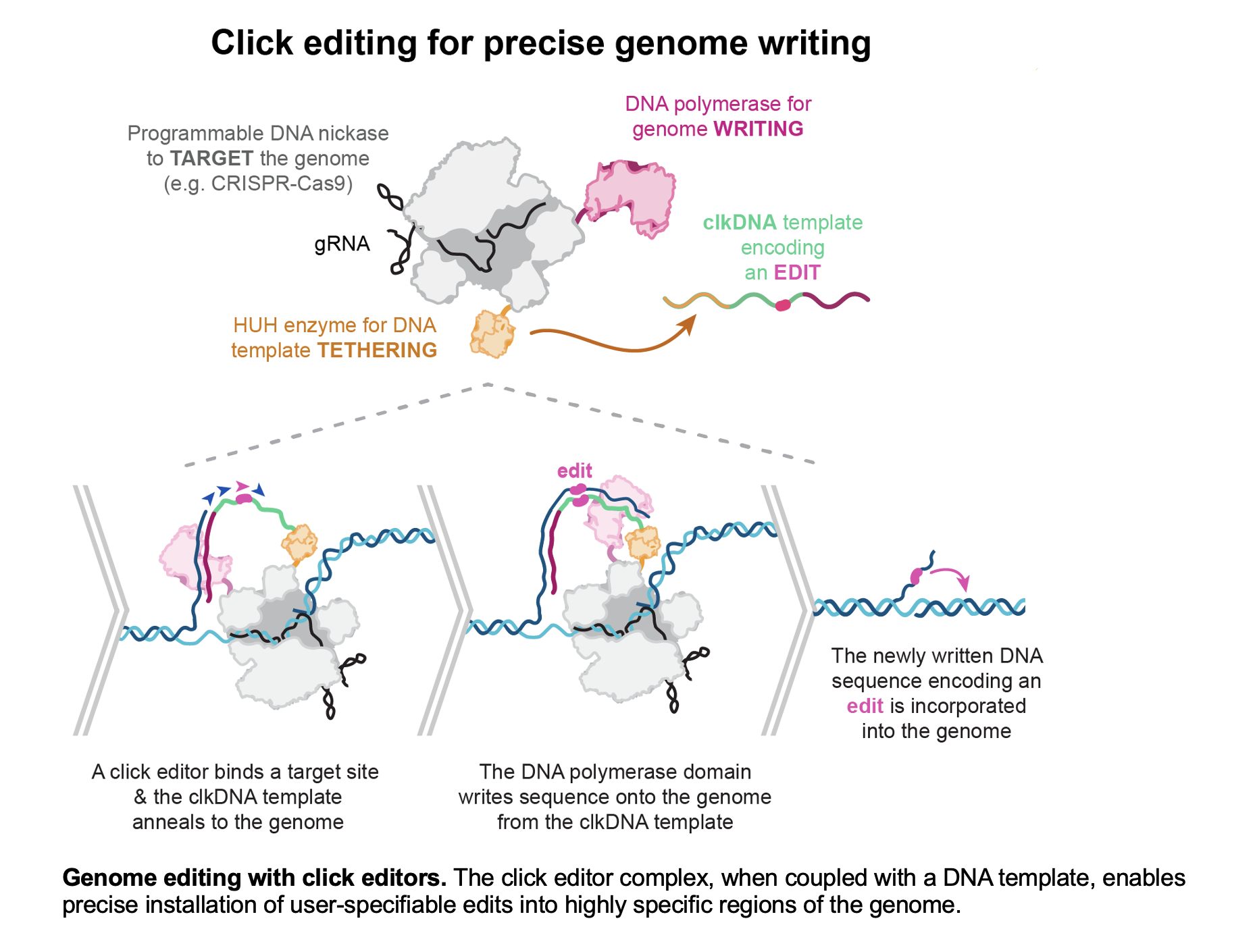NewsJul | 30 | 2024
Research Spotlight: Programmable Genome Writing Via Click Editing with DNA Polymerases and HUH Endonucleases
Joana Ferreira da Silva, PhD, postdoctoral research fellow, and Connor Tou, a PhD candidate in the Center for Genomic Medicine (CGM) at Massachusetts General Hospital are co-first authors of a recently published paper in Nature Biotechnology, Click Editing Enables Programmable Genome Writing Using DNA Polymerases and HUH Endonucleases.
Benjamin Kleinstiver, PhD, an investigator in the CGM and an associate professor at Harvard Medical School, is the senior author. Kleinstiver is also a Kayden-Lambert MGH Research Scholar 2023-2028.
What Question Were You Investigating?
The team of researchers in the Kleinstiver laboratory sought to develop a new genome editing approach that could enable the easy and precise installation of nearly any genetic change into a chromosome.
To do this, they coupled various enzymes together, including a CRISPR-Cas9 protein for targeting the genome, a DNA dependent DNA polymerase (DDP) for DNA writing, and an HUH endonuclease (HUHe) to selectively recruit a single stranded DNA (ssDNA) molecule.
“We envisioned that the use of DDPs, HUHes, and ssDNA templates for genome writing may overcome several challenges of previous technologies and methods.” said co-first author Connor Tou.

What Did You Find?
The click editor enzyme is comprised of an HUHe-Cas9-DDP fusion protein that can use simple ssDNA templates encoding edits-of-interest for precise genome editing. Click editors have key properties that include the ability to target single sites in the genome that are specified by a guide RNA (gRNA), the capacity to recruit an edit-encoding ssDNA template to that target site, and a highly accurate DDP domain that can then write the template-encoded edit into the genome.
Through iterative optimizations, the team developed click editors that enable the installation of nearly any small sequence edit into the genome. The use of HUHes permitted the rapid and scalable screening of nearly one thousand different DNA templates that varied in their parameters (including their lengths and their base compositions, which could modulate DNA repair outcomes), using simple DNA oligonucleotides without expensive chemical modifications or additional cloning steps.
Furthermore, they demonstrated the high-fidelity mechanism of click editing with minimal detectable unwanted off-target edits.
Co-first author Dr. Joana Ferreira da Silva summarized: “We demonstrated that click editing is a precise and highly versatile platform for human genome writing, having a simple workflow and potential for applicability across various biological applications.”
What Are the Potential Clinical Implications?
“Click editing can be applied for different biomedical research applications and we are now exploring its potential in pre-clinical studies to directly correct diverse disease-causing mutations.”, said Kleinstiver.
Due to the use of DDPs, implementation of HUHes, and separation of template and guide molecules, the MGH team is hopeful that CEs will facilitate versatile, efficient, and safe genome editing designs that can be more easily manufactured and optimized (particularly for non-viral delivery).
This study describes the development of a first generation click editor construct, which uses wild-type enzymes and minimally or unmodified clkDNAs. Click editing is therefore a nascent technology that will require further optimization for eventual clinical translation, but there is reason to be optimistic that each component can be engineered to result in a highly efficient and precise genome writing tool.
Co-first authors Joana and Connor are hopeful about the continued engineering of click editors: “We are optimistic about future avenues in CE protein and clkDNA engineering, as well as CE delivery, that will increase click editing efficiency and safety.”, said Joana.
“Expanded conceptions of click editing may enable new editing types and lengths, including those for precise and safe gene-length sequence installation.”, said Connor.
In all, this study describes a large collaborative effort to develop a new genome editing method, click editing, which leverages unique and previously underexplored proteins to add new capabilities to the ‘genome editing toolbox’.
Paper Cited:
Ferreira da Silva J, Tou CJ, King EM, Eller ML, Rufino-Ramos D, Ma L, Cromwell CR, Metovic J, Benning FMC, Chao LH, Eichler FS, Kleinstiver BP. (2024). Click editing enables programmable genome writing using DNA polymerases and HUH endonucleases. Nature Biotechnology, https://www.nature.com/articles/s41587-024-02324-x
Research Briefing:
Precise and versatile genome editing with click editors. (2024) Nature Biotechnology, https://www.nature.com/articles/s41587-024-02340-x
Type
Centers and Departments
Check out the Mass General Research Institute blog
Bench Press highlights the groundbreaking research and boundary-pushing scientists working to improve human health and fight disease.
Support Research at Mass General
Your gift helps fund groundbreaking research aimed at understanding, treating and preventing human disease.
About Massachusetts General Hospital
Massachusetts General Hospital, founded in 1811, is the original and largest teaching hospital of Harvard Medical School. The Mass General Research Institute conducts the largest hospital-based research program in the nation, with annual research operations of more than $1 billion and comprises more than 9,500 researchers working across more than 30 institutes, centers and departments. MGH is a founding member of the Mass General Brigham healthcare system.
